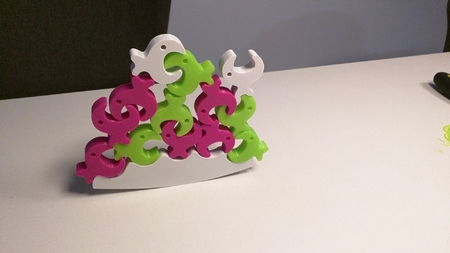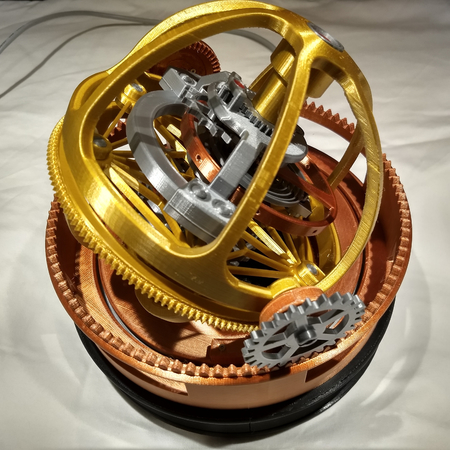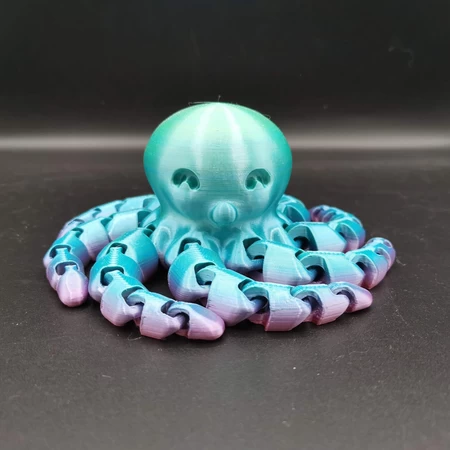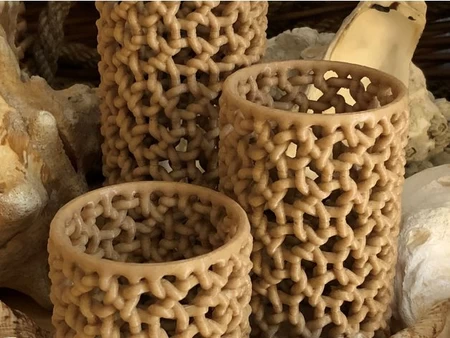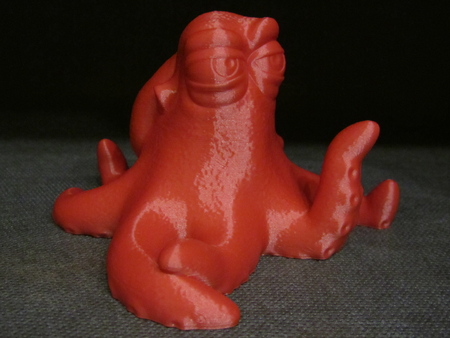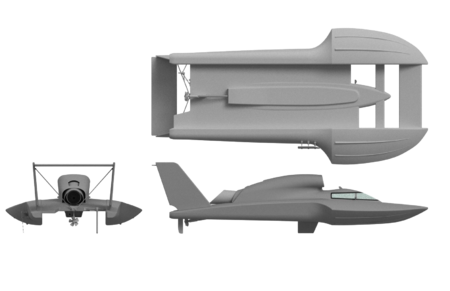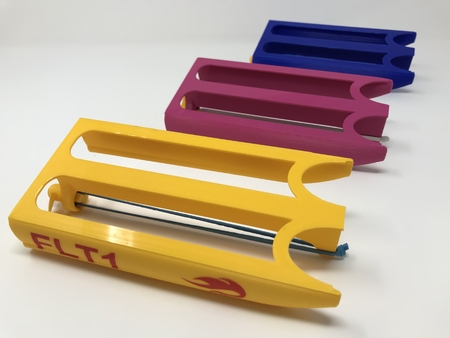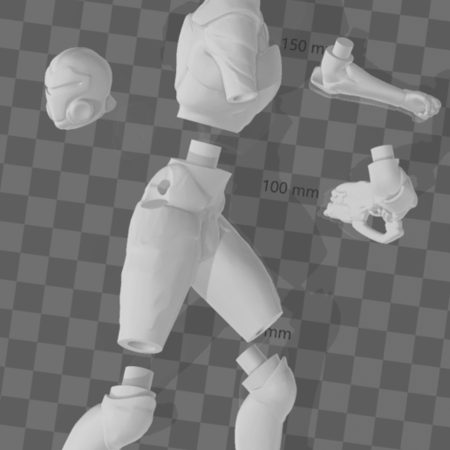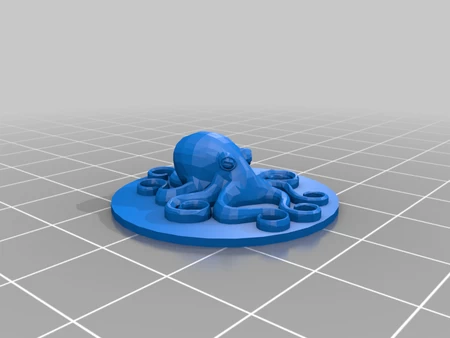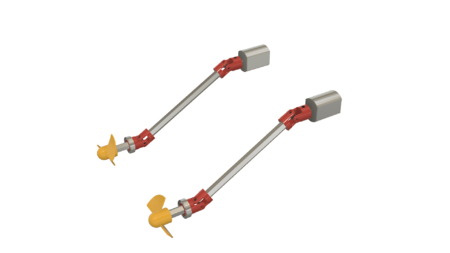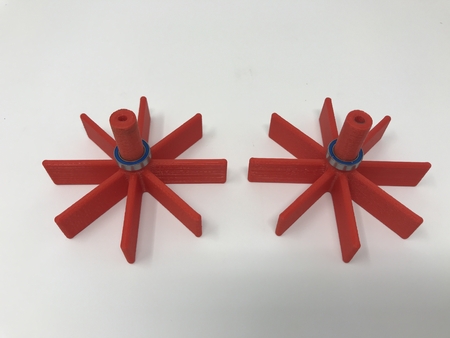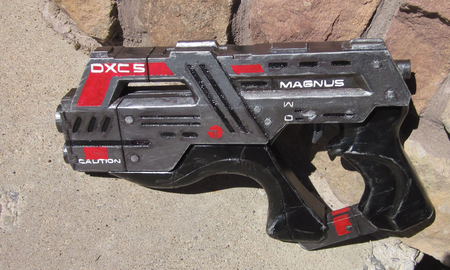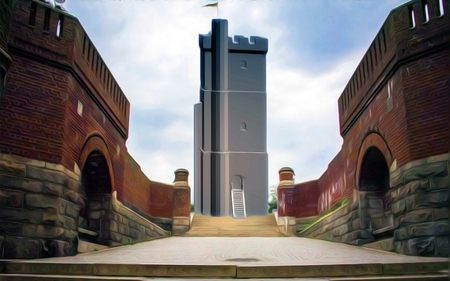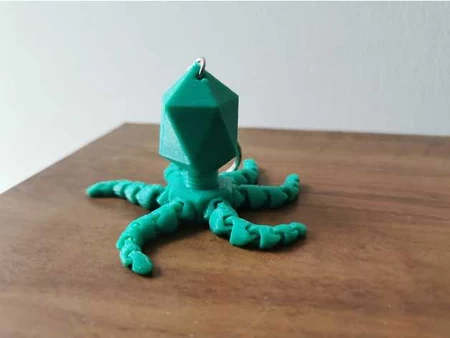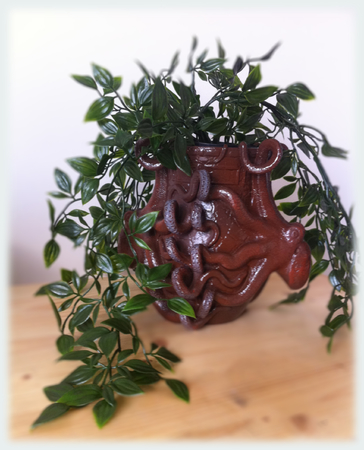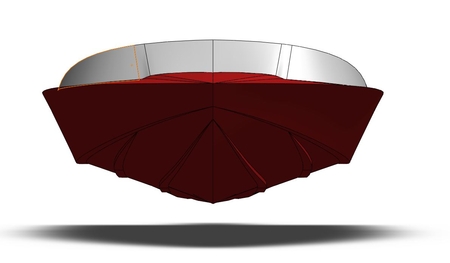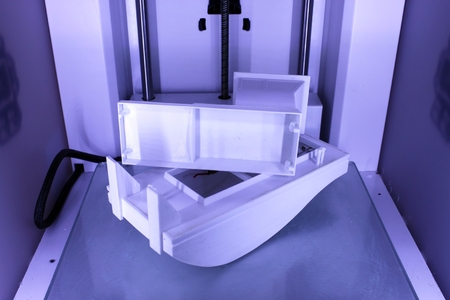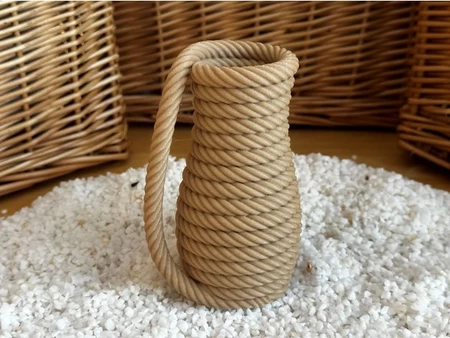Ss ohno en 3D para imprimir
2725 Visualizaciones 2 Me gusta 1 Descargas realizadas Descarga aqui la pieza desde 3dforprint
"SS OhNo" es un caprichoso temática náutica estudio del equilibrio y e...l centro de masa. Equilibrio sobre una base de Pulpo, el SS OhNo, es el capitán, un tiburón hambriento, de jirones de vela y un pájaro que oscilan de proa y popa con un suave empujón en el barco del ancla.
Entre los muchos Autodesk Fusion 360 características avanzadas que he tropezado a través, uno es el centro de la masa. Funciona muy simplemente de la siguiente manera; seleccione "Centro de Masa" de la "Inspeccionar" en el menú, a continuación, seleccione todos los componentes que desea incluir en el centro de la masa de cálculo. Fusion 360, a continuación, mostrará un centro de masa icono en el centro de masa de punto para los componentes seleccionados; brillantemente simple. Para este modelo de equilibrio, sabía que el centro de masa debe estar en o ligeramente por debajo de la quilla de los cilindros, sin embargo, como se indica por la Fusión 360 el centro de masa ligeramente por encima de este punto. Fácilmente se podría haber reducido el centro de masa a través de la utilización de una torre más alta de diseño y bajada de ancla (lo que reduce el centro de masa), pero yo quería una más corta de la torre. Así que para compensar, he diseñado el ancla que incluye un recipiente de masa adicional (más pesado que el PLA) en la forma de BBs, fino modelado de arena o similares de material pesado.
Como de costumbre, probablemente olvidó de un archivo o dos o quién sabe qué otra cosa, así que si usted tiene alguna pregunta, por favor no dude en preguntar como hago errores en la abundancia.
Diseñado utilizando Autodesk Fusion 360, rodajas de uso de Cura 2.5, e impresas en PLA en una Ultimaker 2+ Extendida y una Ultimaker 3 Extendida.
Para completar SS OhNo, usted necesitará un 2 mm de diámetro de alambre de gancho de ropa (encontré... el mío en mi armario, pero están disponibles en la limpieza en seco), y 4.5 mm de diámetro BBS (disponible en línea y en tiendas de artículos deportivos), fino modelado de arena, granalla o similares de material pesado.
Imprimí todas las partes en una Ultimaker 2+ Extendida y una Ultimaker 3 Extendido en .1 mm de resolución vertical y el 100% de relleno de "Ancla.stl", el 20% de relleno para el resto de las partes, y no soporta.
He impreso el barco y el pulpo con doble extrusión y he incluido las partes en ambos ".3mf" y ".stl" (nombre de archivo que termina con "DE") formato. También he incluido las piezas para solo de extrusión.
Antes del montaje, compruebe el ajuste y recorte, archivo, arena, etc. todas las piezas que sean necesarias para el movimiento suave de las superficies en movimiento, y ajuste apretado para no mover las superficies. Dependiendo de los colores que elegiste y la configuración de la impresora, más o menos cortar, limar y/o lijado puede ser requerido. Cuidadosamente todos los bordes que estaban en contacto con la placa de construcción para asegurarnos de que todos placa de construcción "cieno" es retirado y que todos los bordes son lisos. He utilizado un plano joyeros archivo y un montón de paciencia para realizar este paso.
2) Montar la Base.
Seguro De La "Torre De La Bandeja.stl" a la parte superior de la Torre.stl" uso "de la Torre de Tornillo.stl". Esta es la torre de la asamblea.
Pulse la torre de la asamblea en la torre de titular en el pulpo.
Esta es la base de montaje.
3) Montar el Barco.
El ancla de la "cuerda" se realiza mediante una 14cm (aproximadamente 5.5") longitud de la percha. Una vez cortados y lijados, raspar la pintura de ambos extremos, como se muestra a continuación, doblar la cuerda en la forma como se muestra. Pulse el 10mm extremo doblado de la cuerda en la cuerda en el agujero en la parte inferior de la embarcación, como se muestra.
Seguro "De La Quilla.stl" en la parte inferior de la embarcación como se muestra, utilizando los dos "Quilla Tornillo.stl" de los componentes.
Diapositiva "De La Vela.stl" en la ranura del mástil de la embarcación.
Pulse "Pájaro.stl" en la parte superior del mástil para garantizar la vela en su lugar.
El tiburón eje es un 32mm longitud de la percha. Una vez que la corte a la longitud y lijados, pulse el tiburón eje en el agujero del eje en "Tiburón.stl", centrado que 14m m del eje se extiende desde cada lado de los tiburones. Color de mi eje utilizando un marcador permanente azul, ya que es visible en el barco.
El marinero eje es un 10mm longitud de la percha. Una vez que la corte a la longitud y lijados, pulse el marinero eje en el agujero del eje en "Marinero Torso.stl", centrado que 4 mm del eje se extiende desde cada lado de la sailor del torso.
Lugar "Marinero Brazo Izquierdo.stl" en el extremo izquierdo de la sailor del eje. Lugar "Marinero Brazo Derecho.stl" en el extremo derecho de la sailor del eje. Presione ambos marinero brazos en el marinero brazo agujeros en la parte delantera de la embarcación, como se muestra.
Coloque el tiburón en las ranuras en la parte trasera de la embarcación.
4) el Equilibrio y la Vela SS OhNo.
Hay cuatro ajustes para permitir el equilibrio de la SS OhNo; la quilla de la posición se puede ajustar a proa y a popa, el ancla se puede mover arriba y abajo de la cuerda, la cuerda puede ser doblado, y, finalmente, ancla de lastre puede ser ajustado.
Empecé con un total de anclaje de peso de 21 gramos. Mi impresoras imprimen los anclajes con un peso de 11 gramos, y he añadido el 28 de BBs (10 gramos) de lastre para que el ancla y asegurado de ellos en el interior del anclaje con "Tornillo de Anclaje.stl". Una vez montado, pulse el ancla en la cuerda en la posición como se muestra en la fotografía de la portada.
Siguiente, el nivel de la embarcación. Inicio cuidadosamente el posicionamiento de la completa barco de montaje en las ranuras en "la Torre de la Bandeja.stl" y examinar el movimiento de la embarcación. Si es perfectamente nivelado, estás hecho! Pero lo más probable es que no será de nivel y hacer diversos ajustes necesarios. Mi SS OhNos simplemente se requiere ajuste de quilla. Si la nariz de la embarcación era alto, me deslizó la quilla hacia la parte trasera de la embarcación, y si la nariz era baja, me deslicé de la quilla hacia la parte delantera de la embarcación. Una vez en posición, seguro que la quilla en su posición apretando la quilla tornillos.
Finalmente, presiona suavemente el ancla para el rock en el barco. Si se balancea lentamente o se cae la torre, el ancla es todavía demasiado claro (el barco de moverse y caer de la torre) y el lastre adicional es necesaria. Si no hay espacio en el interior para el lastre adicional, a continuación, agregar lastre en la parte trasera de el ancla es una opción. Pegamento cualquiera de las arandelas, las longitudes de gancho de ropa, etc. a la parte de atrás hasta que el barco se balancea con un suave movimiento oscilante.
Feliz viaje!
Diseñador
Greg ZumwaltDescripción del modelo 3d
Un caprichoso temática náutica estudio del equilibrio y el centro de masa."SS OhNo" es un caprichoso temática náutica estudio del equilibrio y e...l centro de masa. Equilibrio sobre una base de Pulpo, el SS OhNo, es el capitán, un tiburón hambriento, de jirones de vela y un pájaro que oscilan de proa y popa con un suave empujón en el barco del ancla.
Entre los muchos Autodesk Fusion 360 características avanzadas que he tropezado a través, uno es el centro de la masa. Funciona muy simplemente de la siguiente manera; seleccione "Centro de Masa" de la "Inspeccionar" en el menú, a continuación, seleccione todos los componentes que desea incluir en el centro de la masa de cálculo. Fusion 360, a continuación, mostrará un centro de masa icono en el centro de masa de punto para los componentes seleccionados; brillantemente simple. Para este modelo de equilibrio, sabía que el centro de masa debe estar en o ligeramente por debajo de la quilla de los cilindros, sin embargo, como se indica por la Fusión 360 el centro de masa ligeramente por encima de este punto. Fácilmente se podría haber reducido el centro de masa a través de la utilización de una torre más alta de diseño y bajada de ancla (lo que reduce el centro de masa), pero yo quería una más corta de la torre. Así que para compensar, he diseñado el ancla que incluye un recipiente de masa adicional (más pesado que el PLA) en la forma de BBs, fino modelado de arena o similares de material pesado.
Como de costumbre, probablemente olvidó de un archivo o dos o quién sabe qué otra cosa, así que si usted tiene alguna pregunta, por favor no dude en preguntar como hago errores en la abundancia.
Diseñado utilizando Autodesk Fusion 360, rodajas de uso de Cura 2.5, e impresas en PLA en una Ultimaker 2+ Extendida y una Ultimaker 3 Extendida.
Parametros de impresión 3d
1) la Compra, Imprimir y Preparar las Piezas.Para completar SS OhNo, usted necesitará un 2 mm de diámetro de alambre de gancho de ropa (encontré... el mío en mi armario, pero están disponibles en la limpieza en seco), y 4.5 mm de diámetro BBS (disponible en línea y en tiendas de artículos deportivos), fino modelado de arena, granalla o similares de material pesado.
Imprimí todas las partes en una Ultimaker 2+ Extendida y una Ultimaker 3 Extendido en .1 mm de resolución vertical y el 100% de relleno de "Ancla.stl", el 20% de relleno para el resto de las partes, y no soporta.
He impreso el barco y el pulpo con doble extrusión y he incluido las partes en ambos ".3mf" y ".stl" (nombre de archivo que termina con "DE") formato. También he incluido las piezas para solo de extrusión.
Antes del montaje, compruebe el ajuste y recorte, archivo, arena, etc. todas las piezas que sean necesarias para el movimiento suave de las superficies en movimiento, y ajuste apretado para no mover las superficies. Dependiendo de los colores que elegiste y la configuración de la impresora, más o menos cortar, limar y/o lijado puede ser requerido. Cuidadosamente todos los bordes que estaban en contacto con la placa de construcción para asegurarnos de que todos placa de construcción "cieno" es retirado y que todos los bordes son lisos. He utilizado un plano joyeros archivo y un montón de paciencia para realizar este paso.
2) Montar la Base.
Seguro De La "Torre De La Bandeja.stl" a la parte superior de la Torre.stl" uso "de la Torre de Tornillo.stl". Esta es la torre de la asamblea.
Pulse la torre de la asamblea en la torre de titular en el pulpo.
Esta es la base de montaje.
3) Montar el Barco.
El ancla de la "cuerda" se realiza mediante una 14cm (aproximadamente 5.5") longitud de la percha. Una vez cortados y lijados, raspar la pintura de ambos extremos, como se muestra a continuación, doblar la cuerda en la forma como se muestra. Pulse el 10mm extremo doblado de la cuerda en la cuerda en el agujero en la parte inferior de la embarcación, como se muestra.
Seguro "De La Quilla.stl" en la parte inferior de la embarcación como se muestra, utilizando los dos "Quilla Tornillo.stl" de los componentes.
Diapositiva "De La Vela.stl" en la ranura del mástil de la embarcación.
Pulse "Pájaro.stl" en la parte superior del mástil para garantizar la vela en su lugar.
El tiburón eje es un 32mm longitud de la percha. Una vez que la corte a la longitud y lijados, pulse el tiburón eje en el agujero del eje en "Tiburón.stl", centrado que 14m m del eje se extiende desde cada lado de los tiburones. Color de mi eje utilizando un marcador permanente azul, ya que es visible en el barco.
El marinero eje es un 10mm longitud de la percha. Una vez que la corte a la longitud y lijados, pulse el marinero eje en el agujero del eje en "Marinero Torso.stl", centrado que 4 mm del eje se extiende desde cada lado de la sailor del torso.
Lugar "Marinero Brazo Izquierdo.stl" en el extremo izquierdo de la sailor del eje. Lugar "Marinero Brazo Derecho.stl" en el extremo derecho de la sailor del eje. Presione ambos marinero brazos en el marinero brazo agujeros en la parte delantera de la embarcación, como se muestra.
Coloque el tiburón en las ranuras en la parte trasera de la embarcación.
4) el Equilibrio y la Vela SS OhNo.
Hay cuatro ajustes para permitir el equilibrio de la SS OhNo; la quilla de la posición se puede ajustar a proa y a popa, el ancla se puede mover arriba y abajo de la cuerda, la cuerda puede ser doblado, y, finalmente, ancla de lastre puede ser ajustado.
Empecé con un total de anclaje de peso de 21 gramos. Mi impresoras imprimen los anclajes con un peso de 11 gramos, y he añadido el 28 de BBs (10 gramos) de lastre para que el ancla y asegurado de ellos en el interior del anclaje con "Tornillo de Anclaje.stl". Una vez montado, pulse el ancla en la cuerda en la posición como se muestra en la fotografía de la portada.
Siguiente, el nivel de la embarcación. Inicio cuidadosamente el posicionamiento de la completa barco de montaje en las ranuras en "la Torre de la Bandeja.stl" y examinar el movimiento de la embarcación. Si es perfectamente nivelado, estás hecho! Pero lo más probable es que no será de nivel y hacer diversos ajustes necesarios. Mi SS OhNos simplemente se requiere ajuste de quilla. Si la nariz de la embarcación era alto, me deslizó la quilla hacia la parte trasera de la embarcación, y si la nariz era baja, me deslicé de la quilla hacia la parte delantera de la embarcación. Una vez en posición, seguro que la quilla en su posición apretando la quilla tornillos.
Finalmente, presiona suavemente el ancla para el rock en el barco. Si se balancea lentamente o se cae la torre, el ancla es todavía demasiado claro (el barco de moverse y caer de la torre) y el lastre adicional es necesaria. Si no hay espacio en el interior para el lastre adicional, a continuación, agregar lastre en la parte trasera de el ancla es una opción. Pegamento cualquiera de las arandelas, las longitudes de gancho de ropa, etc. a la parte de atrás hasta que el barco se balancea con un suave movimiento oscilante.
Feliz viaje!



